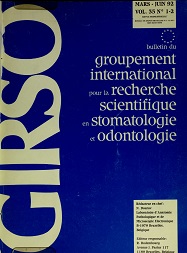Mechanical holding and biocompatibility of various modern conceptions of removable partial dentures with free saddles
Keywords:
dentures with three saddles, split plates, mechanical holding, biocompatibility, strength frameworksAbstract
This research is aimed to check the mechanical holding and the biocompatibility at various conceptions of removable partial dentures with free saddles, constituted from stellite alloys.
As a matter of fact, the duality of the supporting surface in this kind of dental prothesis sets biological problems, that one must try to sort out in the best way.
It consists of three in vitro experimentations to point out the type or the types of framework answering in the best way to biomechanical and biological requirements.
The very same equipment has been used on that three expérimentations adapting it to the needs. It’s «a machine to Overdrive», imagined into the building of «L’Ecole supérieure d’Aéronautique de Toulouse»; this machine is made of an electric engine with an axis of rotation, of two speed reducers giving a motion, of one turn by second, of a knee- joint converting a rotary motion to an alternating motion, of a lever-arm enclosing supporting the weights, of a needle with a foam point which secure the saddles or the strategic zones, of two supporting mandibula and maxillary framework resin patterns, and on the areas representing the osteo-mucosa support capped uniformly with a compressible silicone material of on millimetre thick, of one dynamometer and of an accurate comparator to check the strength used, and the displacement tested zones.
The first part consists in testing the amplitude of the saddle displacement and the mobilization of strategic joining areas from various frameworks used. So we can infer the impact on the mucosa during the function.
That is why six types of frameworks have been achieved in Wironit stellite alloy showing mechanical qualities admitted to be excellent and tobe subject to very accurate experiment conditions with 30 Kz strength (Lundeen and Gibbs, 1982).
The results are interpreted through the reading of histogramms which X-AXIS represent the points where motions have been located and the Y-AXIS represent the motion at l/100th millimetre. It allows to show the existence more or less important of the saddle displacement which is not far from the mucosa one and constitute therefore on the biological view point a favourable component but also the existence of tensions in level of some strategic zones which let forsee, for same, a risk of weariness.
The second part deals with the toughness to weariness of six types of frameworks in use. Two specimens of each type have been cast, wholly, it makes twelve frameworks. The motions causing the strength come from vertical alternating cycles: they cause an amplitude of the saddle displacement close to the one found during the first experimentation, never going beyond one millimetre. The weariness tests are continuous in the course of the time represent the outcome of the work of the frameworks during a definite number of years and paying respect to the international norms (Glickman, 1974), as for the daily quantity of chewing and deglutition. Each framework undergo the identical time of weariness to be able to confront the results achevied.
Each sample is under checking by metallographic microscope during ail the experimentation and at the end. Two boards record the results which allow to come to conclusion for the better toughness of the mandibula frameworks and of the maxillar split plates.
The third part is aimed to test the weariness of the split plates in use, with different alloys: the Wironit, the Swedion, the Vitallium, the Chromix 65/7, making varie two parameters concerning the plates conception. Those are due to the split orientation and to a present or missing terminal circle.
Twenty four frameworks are tested, one of each conception and of each alloy. A.S.E.M. and a metallographic microscope are foreseen to analyse the alloys microstructure and to test the metallic fissure.
Four boards summarize the microscopic study and allow to so sort out the pratical inferences concerning the quality of the alloys that we used and the two foreseen parameters, but also to come to the conclusion by the way that the biointegration of the straight split plates with terminal circle is evident.
The biological answer of the mucosa under the saddles is tested with the microscope. The biopsies are cut off under the saddles on twelve patients. The answer is excellent.
Downloads
Published
Issue
Section
License
I hereby certify that the authors of the above manuscript have all:
1. Conceived, planned, and performed the work leading to the report, or interpreted the evidence presented, or both;
2. Written the report or reviewed successive versions and shared in their revisions; and
3. Approved the final version.
Further, I certify that:
1. This work has not been published elsewhere and is not under revision in another journal;
2. Humane procedures have been followed in the treatment of experimental animals (if applicable);
3. Investigations in humans was done in accordance with the ethical standards of the responsible committee on human experimentation or with the Helsinki Declaration (if applicable).
4. This paper has been carefully read by a native English speaker who is familiar with the field of work (this applies to authors who are not fluent in English); and
5. The copyright of the article is transferred from the authors to the Bulletin du Groupement International pour la Recherche Scientifique en Stomatologie et Odontologie upon acceptance of the manuscript.



